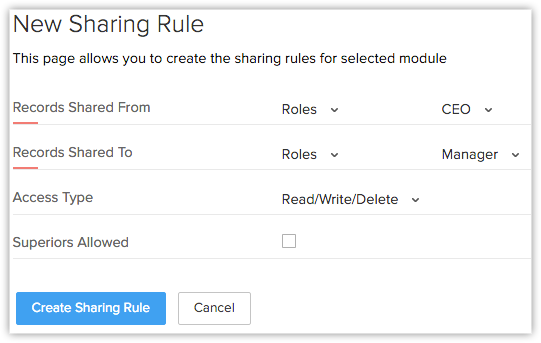Creating Data Sharing Rules
This feature helps you to create rules to provide access or restrict users from viewing your data in various modules.
Availability
To create data sharing rules
- Click Setup > Users & Permissions > Data Sharing Settings.
- In the Data Sharing Settings page, click New Sharing Rule for the corresponding module.
- In the New Sharing Rule page, do the following:
- Specify from whom the records are shared.

- Specify to whom the records are shared.
- Choose the Access Type from the drop-down list.
- Select the Superiors Allowed check box to allow data sharing to the superiors.
- Specify from whom the records are shared.
- Click Create Sharing Rule.
Related Articles
Setting up Data Sharing Rules
Managing Default Data Sharing Process You can provide the following types of access levels to user in Client management system modules: Private: Only the record owner and his/her superior can view the record. Public Read only: Users can view others' ...Security Management-Data Sharing Rules
By default, access rights to CRM records is set as private so that the record owner and his/her manager can oversee the CRM data. However, using the Data Sharing Rules, you can extend the access rights to users belonging to other roles and groups. ...Manage Data Sharing
Managing Default Data Sharing Process You can provide the following types of access levels to user in Zoho CRM modules: Private: Only the record owner and his/her superior can view the record. Public Read only: Users can view others' records but ...Creating Leads
In CRM, you can create leads by: Entering data in the lead details form: You can manually fill in the Lead details gathered from various external sources, e.g. trade shows, exhibitions, colleagues, business cards, etc. Importing leads from external ...Creating Profile
While creating a profile, first you have to associate the existing profile to the new profile and later you can change the modules and field-level access control. The table below provides information on the default profiles and the additional ...